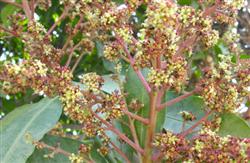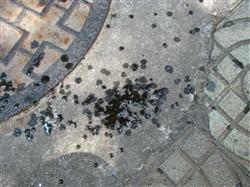How to control diseases and insect pests in flowering and young fruit stage of mango

The main diseases of mango in flowering stage are powdery mildew and anthracnose, and the pests are leafhoppers and aphids. Improper control will lead to a serious reduction in yield and fruit quality. Powdery mildew symptoms: the disease is mainly harmful to flowers, fruits, leaves, seedlings and young shoots. Powdery spots first appear in the susceptible site, and then gradually combine to form a layer of white powder. The flowers stopped blooming after being killed, and then fell off. The young fruit was first covered with powdery matter, then the diseased part of the skin cracked and corked, and the diseased fruit fell off when it grew to the size of the pea. The drugs for the prevention and control of powdery mildew are: methomyl suspension (prohibited in full bloom), triadimefon, triadimefon, Dasheng M-45, methyl thiophanate, mancozeb and carbendazim. Anthrax symptoms: the disease is mainly harmful to tender leaves, flowers, fruits and shoots. After the flower is infected, there are some small spots, and finally it turns black and rotten and cannot bear fruit. After infection, the young fruit is deformed, blackened and shedding. The prevention and treatment of anthracnose can choose four-base topiramate, mancozeb, carbendan, carbendazim and other agents. Mango leafhopper and aphid droppings can cause soot disease. If there are soot or oily bright spots on mango leaves, there are often a large number of leafhoppers or aphids above them. The leafhopper is shaped like a cicada and the adult is dark and feathered, with a volume of 4mi 5mm and a nymph of orange or light yellow with a body length of 1mm. Aphids are fatter, winged ones are about 1.6 mm long, wings are colorless and transparent, wingless aphids are about 2 mm long, and nymphs are wingless and smaller. Leafhopper control agents: dimethoate EC, malathion emulsion, dimethoate, dimethoate. Aphid control agents: dimethoate EC, malathion emulsion, Baike, kung fu. If the above diseases and insect pests are found, one or two kinds of agents should be selected for the control of diseases and insect pests, and the method of use should be re-sprayed with different agents every 10 days according to the instructions. If a variety of diseases and insect pests occur at the same time, it can be sprayed by itself, such as: Mianbaike + methyl thiophanate + strychnine, but it should be used now. Click to get more mango planting techniques click to get more fruit planting techniques
- Prev

How to improve the fruit setting rate of grapes
How to improve the fruit setting rate of grapes
- Next

How to control the gummy disease of mango shoot
What is mango shoot withered gum disease? Is there any way to carry out effective prevention and control? The gummy disease of mango shoot mainly harms the shoot and trunk, causing it to wither, but it can also harm seedlings and fruits. Most of the damage to the seedlings appeared dark-brown necrotic spots from the bud contact or wound, which quickly developed up and down, resulting in scion necrosis. ...
Related
- Moge, come on! The staff of the peasant association in the producing area of cantaloupe were frightened when the crowd gathered.
- Causes and Solutions of low Fruit setting rate of Apple
- Symptoms and control measures of passion fruit virus disease
- Fruit growing lesson: how do apple orchards keep high yields?
- Can you build orchards in the mountains? What are the pros and cons?
- How to manage the coloring period of Crisson grape?
- This paper introduces the processing technology of two kinds of fig products.
- How much is a month for retired teachers in rural areas by 2020?
- How can strawberry planting increase sugar content? We should pay attention to management in many aspects.
- What are the cultivation techniques on how to improve the yield of golden fruit?

